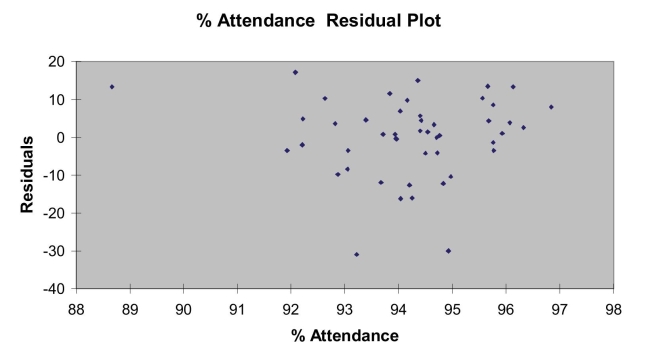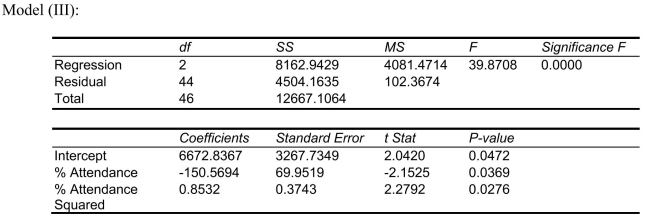SCENARIO 15-4 The superintendent of a school district wanted to predict the percentage of students passing a sixth-grade proficiency test.She obtained the data on percentage of students passing the proficiency test (% Passing) , daily mean of the percentage of students attending class (% Attendance) , mean teacher salary in dollars (Salaries) , and instructional spending per pupil in dollars (Spending) of 47 schools in the state. Let Y = % Passing as the dependent variable,  Attendance,
Attendance,  Salaries and
Salaries and  Spending. The coefficient of multiple determination (
Spending. The coefficient of multiple determination (  ) of each of the 3 predictors with all the other remaining predictors are, respectively, 0.0338, 0.4669, and 0.4743. The output from the best-subset regressions is given below:
) of each of the 3 predictors with all the other remaining predictors are, respectively, 0.0338, 0.4669, and 0.4743. The output from the best-subset regressions is given below:  Following is the residual plot for % Attendance:
Following is the residual plot for % Attendance:  Following is the output of several multiple regression models:
Following is the output of several multiple regression models: 


-Referring to Scenario 15-4, which of the following predictors should first be dropped to remove collinearity?
Definitions:
Increase Production
The process of raising the output or quantity of goods and services produced by a firm or country.
Nonrefundable Ticket
A ticket purchase that cannot be returned for a refund, often cheaper than refundable options and common in air travel.
Remainder
The amount left over or remaining after division or allocation.
Alternative
An option or choice that is available as a substitute or replacement for something else.
Q67: Referring to Scenario 15-6, what is the
Q72: Referring to Scenario 14-15, you can conclude
Q74: Referring to Scenario 17-4, the highest mean
Q96: Referring to Scenario 15-6, what is the
Q115: Referring to Scenario 18-8, what is the
Q139: For time intervals exceeding one year and
Q147: In selecting an appropriate forecasting model, the
Q232: Suppose the probability of a power outage
Q256: Referring to Scenario 14-4, the value of
Q310: Referring to Scenario 18-1, what minimum annual